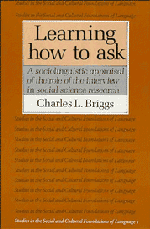 Learning How to Ask
Learning How to Ask Book contents
- Frontmatter
- Contents
- Foreword by Aaron V. Cicourel
- Preface
- 1 Introduction
- 2 The setting: Mexicano society and Córdova, New Mexico
- 3 Interview techniques vis-à-vis native metacommunicative repertoires; or, on the analysis of communicative blunders
- 4 The acquisition of metacommunicative competence
- 5 Listen before you leap: toward methodological sophistication
- 6 Conclusion: theoretical quagmires and “purely methodological” issues
- Notes
- References
- Index
3 - Interview techniques vis-à-vis native metacommunicative repertoires; or, on the analysis of communicative blunders
Published online by Cambridge University Press: 05 June 2012
- Frontmatter
- Contents
- Foreword by Aaron V. Cicourel
- Preface
- 1 Introduction
- 2 The setting: Mexicano society and Córdova, New Mexico
- 3 Interview techniques vis-à-vis native metacommunicative repertoires; or, on the analysis of communicative blunders
- 4 The acquisition of metacommunicative competence
- 5 Listen before you leap: toward methodological sophistication
- 6 Conclusion: theoretical quagmires and “purely methodological” issues
- Notes
- References
- Index
Summary
As noted in Chapter 2, Mexicanos draw on a wide range of accepted speech forms, and they know intuitively which types of expressions are appropriate for which social contexts. Growing up in a given speech community presents the language learner with innumerable opportunities to discover the rules that relate form, context, and meaning. When a researcher leaves her or his own native speech community and establishes contact with another group of human beings, however, no such common body of experience is available to smooth the initial encounters. The same problem arises when investigators work with a different social class or ethnic group within their own society. In filling this gap, researchers commonly draw on the communicative device their speech community views as the best means of obtaining large bodies of information in the least amount of time–the interview. The implicit reasoning seems to be that interviews allow the researcher to assume control of the type and quantity of information being conveyed. This enables him or her to circumvent the usual constraints on the transmission of knowledge (e.g., kinship, age, degree of intimacy, gender, initiation, etc.)
I will argue that this process is really not quite as smooth and successful as we seem to imagine. Our ability to banish the native communicative norms that operate in other environments is far from complete, and the natives' own discourse rules have an odd way of infiltrating the interview.
- Type
- Chapter
- Information
- Learning How to AskA Sociolinguistic Appraisal of the Role of the Interview in Social Science Research, pp. 39 - 60Publisher: Cambridge University PressPrint publication year: 1986
- 1
- Cited by


